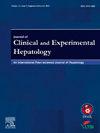Therapeutic Plasma Exchange in Hepatology: Indications, Techniques, and Practical Application
IF 3.3
Q2 GASTROENTEROLOGY & HEPATOLOGY
Journal of Clinical and Experimental Hepatology
Pub Date : 2024-09-13
DOI:10.1016/j.jceh.2024.102410
引用次数: 0
Abstract
It is sobering that many liver failure patients die in the absence of liver transplantation (LT), and reducing its morbidity and mortality urgently needs more non-transplant treatment options. Among the several artificial liver support devices available, therapeutic plasma exchange (TPE) is the only one that improves survival in acute liver failure (ALF) patients. In many other disorders, data on survival benefits and successful bridging to transplant is encouraging. TPE removes the entire plasma, including damage-associated-molecular patterns, and replaces it with healthy donor fresh frozen plasma. In contrast, other artificial liver support systems (ALSS) correct the blood composition through dialysis techniques. TPE has become increasingly popular due to advances in apheresis techniques and a better understanding of its applicability in treating liver failure's pathophysiology. It provides metabolicdetoxification, and synthetic functions and modulates early innate immunity, fulfilling the role of ALSS. TPE is readily available in intensive care units, dialysis units, or blood banks and has enormous potential to improve survival outcomes. Hepatologists must take advantage of this treatment option by thoroughly understanding its most frequent indications and its rationale and techniques. This primer on TPE for liver clinicians covers its current clinical, technical, and practical applications, addresses the knowledge gaps, and provides future directions.
肝病学中的治疗性血浆置换:适应症、技术和实际应用
令人痛心的是,许多肝衰竭患者在没有进行肝移植的情况下死亡,降低肝衰竭的发病率和死亡率迫切需要更多的非移植治疗方案。在现有的几种人工肝支持设备中,治疗性血浆置换(TPE)是唯一一种能提高急性肝衰竭(ALF)患者存活率的设备。在许多其他疾病中,有关存活率和成功过渡到移植的数据令人鼓舞。TPE 清除了整个血浆,包括损伤相关的分子模式,并用健康捐献者的新鲜冷冻血浆取而代之。相比之下,其他人工肝支持系统(ALSS)通过透析技术纠正血液成分。由于无细胞疗法技术的进步,以及对其在治疗肝衰竭病理生理学方面的适用性有了更好的了解,TPE 变得越来越受欢迎。它具有代谢、解毒和合成功能,并能调节早期先天性免疫,发挥 ALSS 的作用。TPE 可在重症监护室、透析室或血库中随时获得,在改善生存结果方面具有巨大潜力。肝病医生必须彻底了解其最常见的适应症及其原理和技术,从而充分利用这种治疗方法。这本为肝脏临床医生编写的 TPE 入门指南涵盖了当前的临床、技术和实际应用,解决了知识空白,并提供了未来的发展方向。
本文章由计算机程序翻译,如有差异,请以英文原文为准。
求助全文
约1分钟内获得全文
求助全文
来源期刊

Journal of Clinical and Experimental Hepatology
GASTROENTEROLOGY & HEPATOLOGY-
CiteScore
4.90
自引率
16.70%
发文量
537
审稿时长
64 days
 求助内容:
求助内容: 应助结果提醒方式:
应助结果提醒方式:


